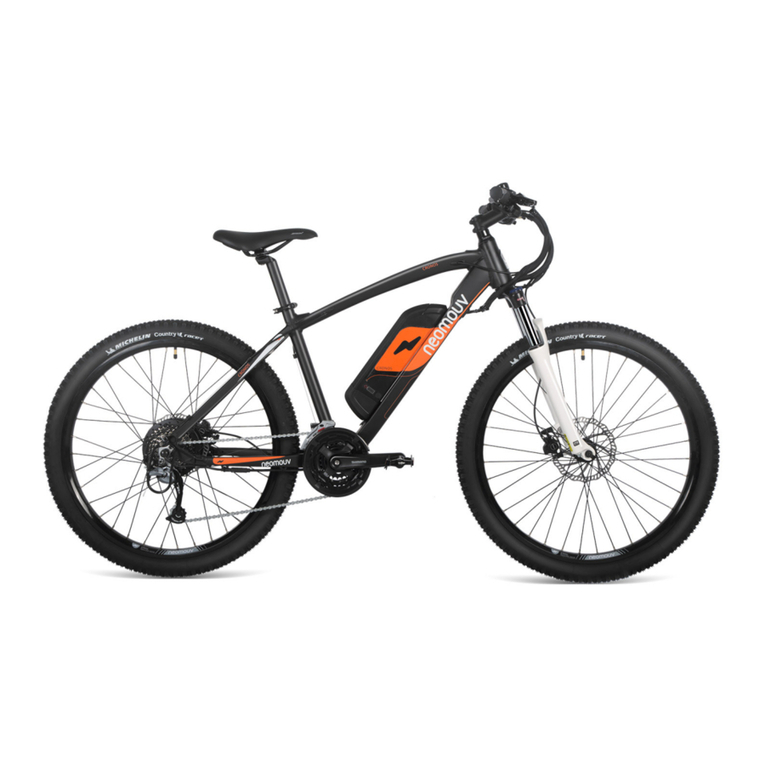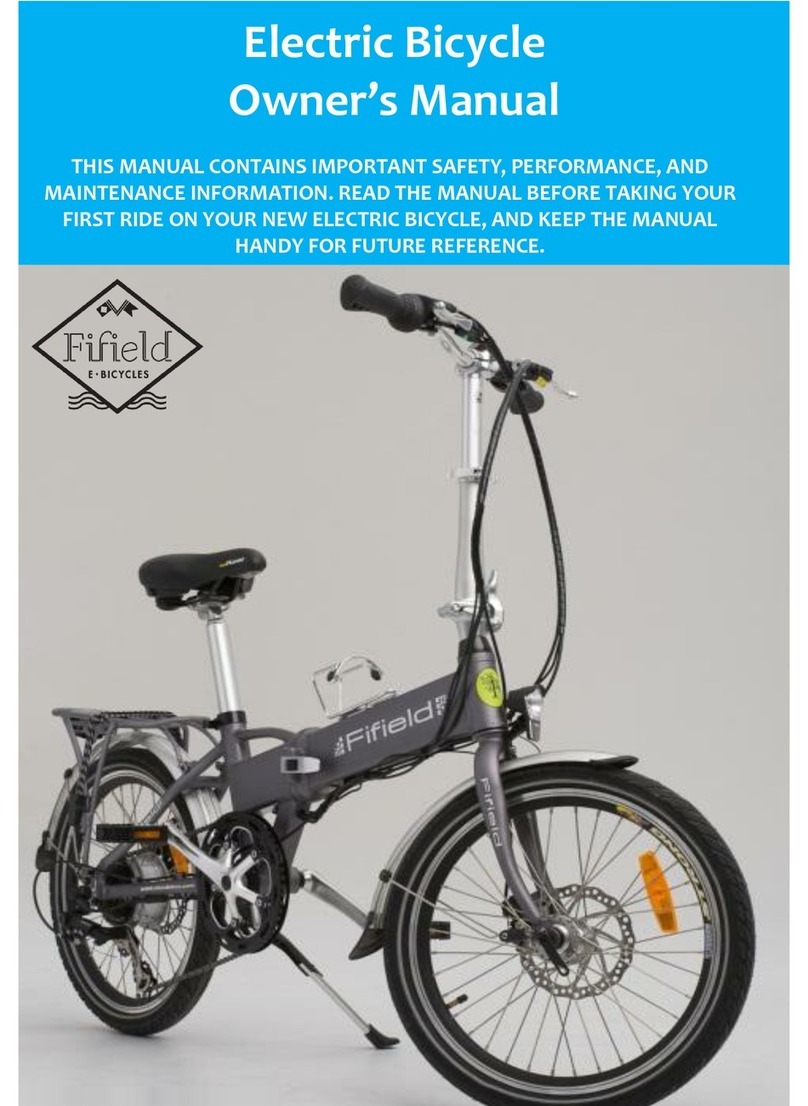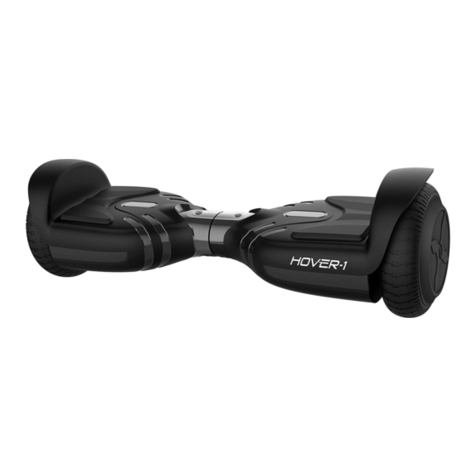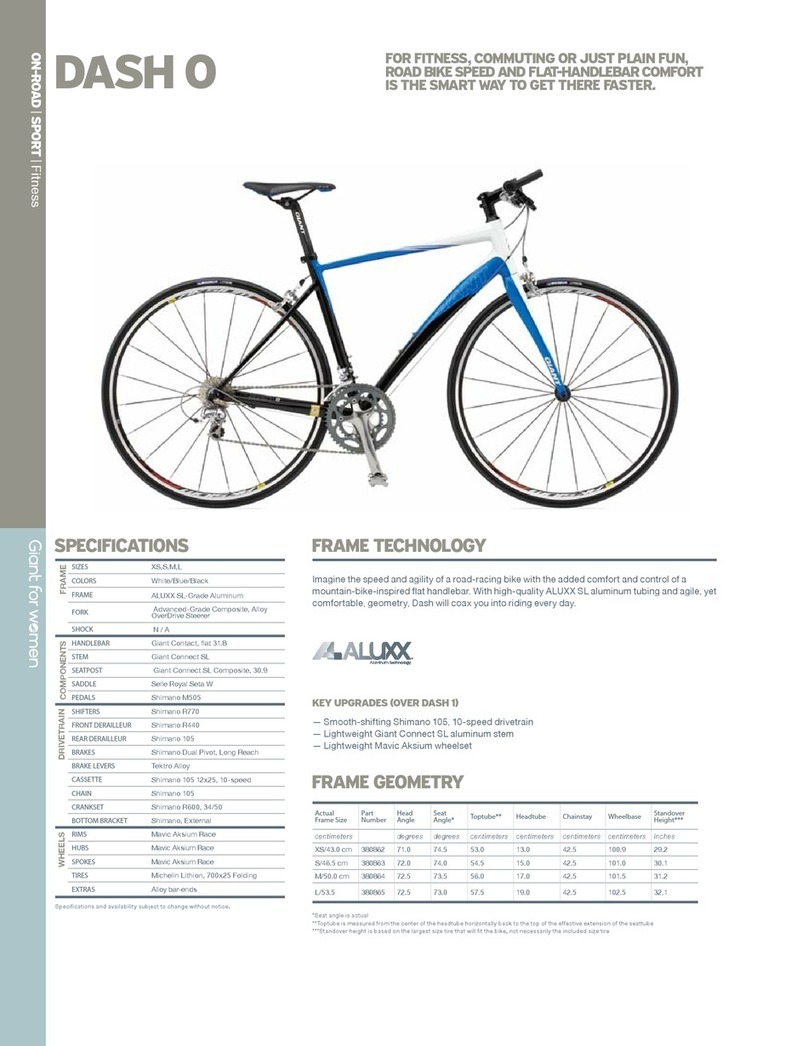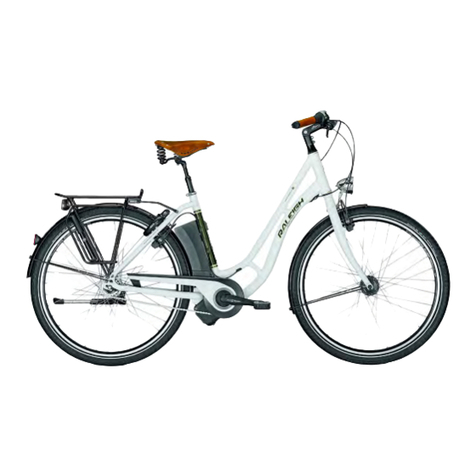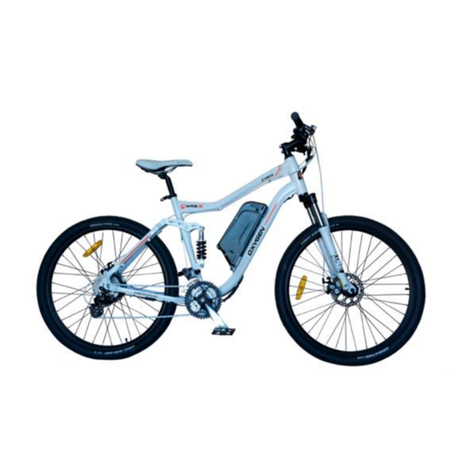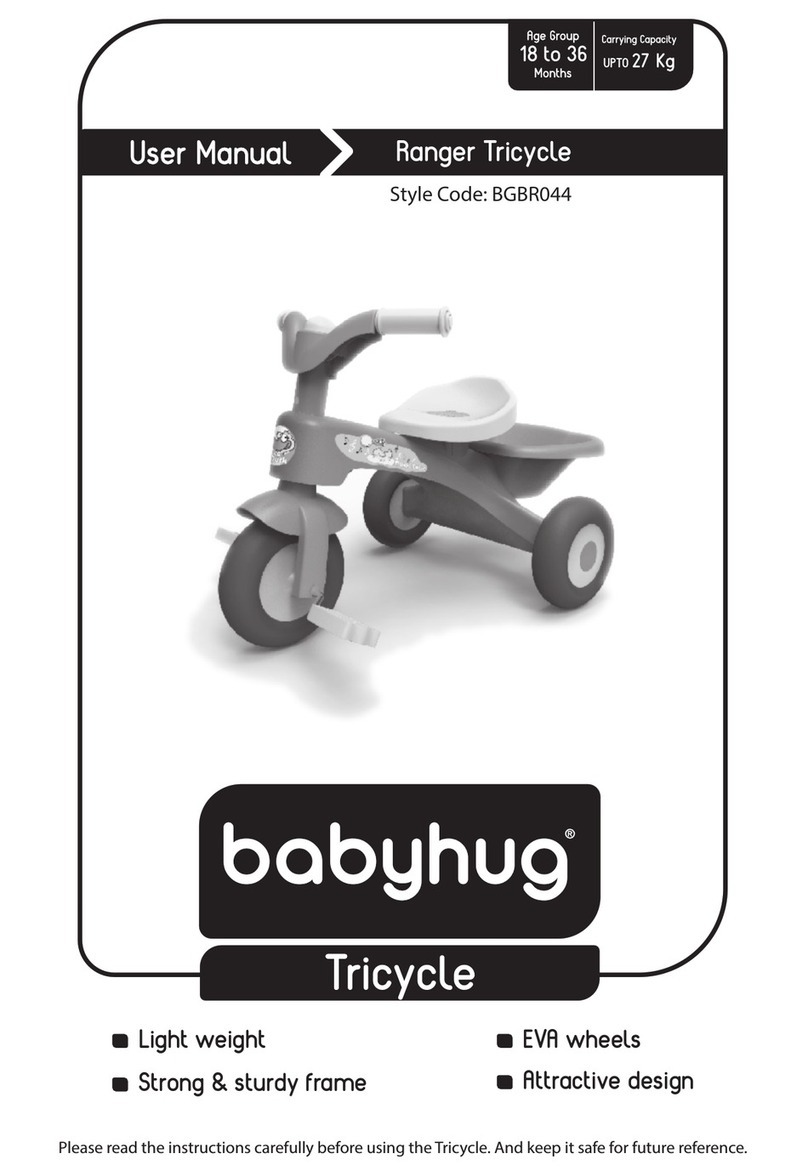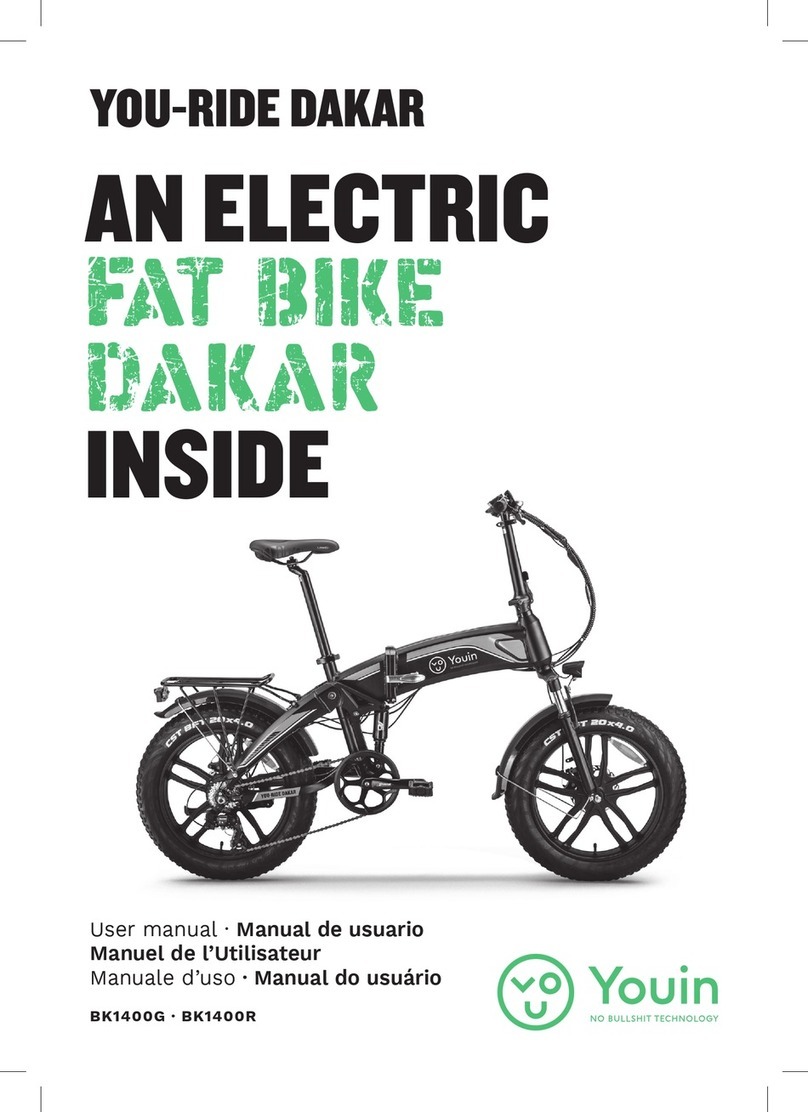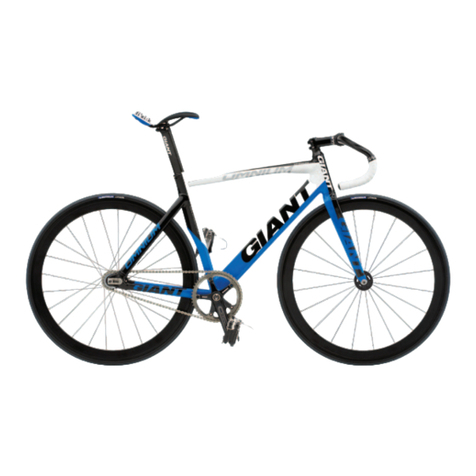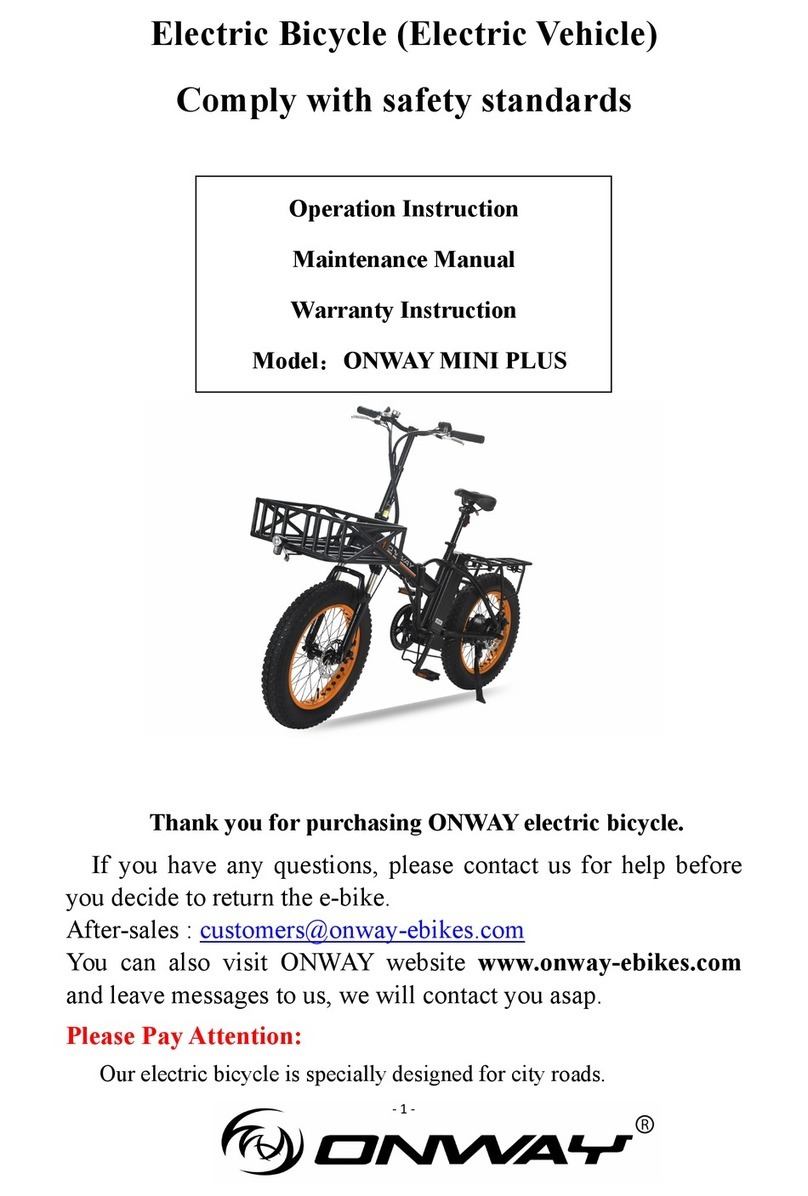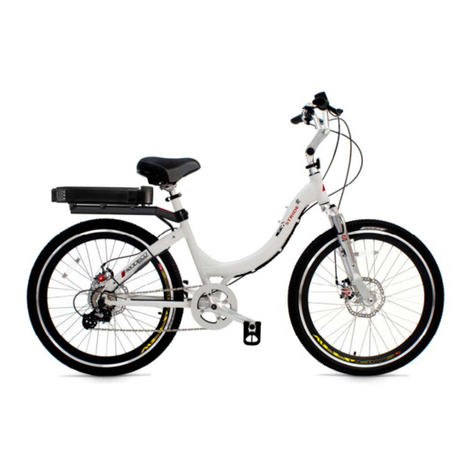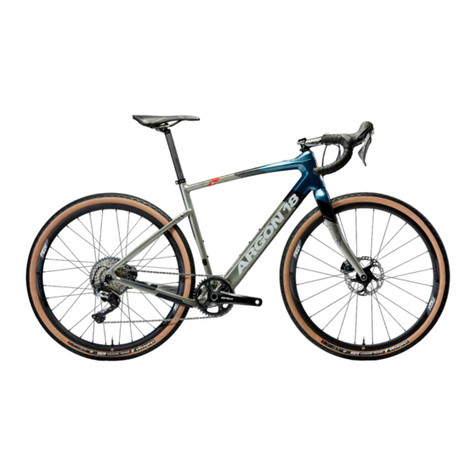neomouv PLIMOA User manual

PLIMOA
USER MANUAL
THIS MANUAL CONTAINS IMPORTANT INSTRUCTIONS FOR
SAFETY AND OPERATION.
"Model complies with the safety requirements"
Photos and data are not binding
11-2019

Manuel PLIMOA
2
SUMMARY
1- INTRODUCTION ........................................................................................................................................... 3
2- ADJUSTMENTS / ASSEMBLY ........................................................................................................................ 4
2.1 Adjusting the saddle: ..................................................................................................................................4
2.1.1 Angle:....................................................................................................................................................4
2.1.2 Height: ..................................................................................................................................................4
2.2 Handlebar adjustment: ...............................................................................................................................5
2.3 Brake adjustment: ......................................................................................................................................6
2.3.1 V-type front brake: .................................................................................................................................6
2.3.2 Rear V-type brake: .................................................................................................................................7
2.4 Luggage rack: ...........................................................................................................................................7
2.5 Mounting and dismounting wheels (rear wheels by specialist): ......................................................................8
2.5.1 Front wheel:...........................................................................................................................................8
2.5.2 Rear wheel: ...........................................................................................................................................8
2.6 Lights: .......................................................................................................................................................9
2.7 Folding the Ebike:.....................................................................................................................................10
3 - USING THE E-BIKE.................................................................................................................................... 13
3.1 Indexed gearshift: ....................................................................................................................................13
3.2 The electronic shift: ..................................................................................................................................13
3.3 The display and control:............................................................................................................................14
3.4 The electric assistance:.............................................................................................................................15
3.4.1 operation: ............................................................................................................................................15
3.4.2 performance: .......................................................................................................................................16
3.4.3 Technical specifications of the assistance system:...................................................................................16
3.4.4 Switching on of the battery: ..................................................................................................................17
3.5 The electric motor: ...................................................................................................................................17
4 - CHARGING THE BATTERY ......................................................................................................................... 18
4.1 NEOMOUV Lithium Ion 36-volt charger ......................................................................................................18
4.1.1 Precautions (safety instructions):...........................................................................................................19
4.1.2 Protecting the charger: .........................................................................................................................19
4.2 Battery: ...................................................................................................................................................20
4.2.1 Battery performance for electric bikes:...................................................................................................21
4.2.2 Recommandations / precautions to take with your battery: .....................................................................22
5 - TIPS FOR INCREASING THE BATTERY LIFE PER CHARGE ........................................................................ 23
6 CARE AND MAINTENANCE........................................................................................................................... 24
6.1 Care:..............................................................................................................................................................24
6.2 Lubrication: ....................................................................................................................................................24
6.3 Maintenance:................................................................................................................................................24
7 - SAFETY - RECOMMENDATIONS................................................................................................................. 25
8 - TECHNICAL DATA...................................................................................................................................... 26
9 - STATEMENT OF CONFORMITY .................................................................................................................. 27
10 - CERTIFICATE OF CONFORMITY .............................................................................................................. 27
11 - WARRANTY CONDITIONS....................................................................................................................... 27

Manuel PLIMOA
3
1- INTRODUCTION
Thank you for choosing a NEOMOUV Electric Bike
E-Bike Overview
Notes:
•The symbol indicates important advice or essential safety measures. Follow the various instructions.
•Some adjustment and assembly/disassembly operations require special tools and expertise; perform
these only if you have the skills to do so, otherwise consult your authorised dealer or a specialist.
•The symbol indicates the tools you will need to carry out adjustments.
•Your e-bike has a serial number engraved on the frame by the fork.
MAXIMUM LOAD:100 KG.FOR YOUR SAFETY IT SHOULD NOT EXCEED THE MAXIMUM LOAD WHEN USING
YOUR BICYCLE.
Battery
Electric motor
Pedal
sensor
Rack
(max load 25 kg)
Controller
Serial number
Display

Manuel PLIMOA
4
2- ADJUSTMENTS / ASSEMBLY
2.1 Adjusting the saddle:
6mm Allen Key
2.1.1 Angle:
Loosen the nut under the saddle.
Adjust the angle of the saddle in order to find your most comfortable position. Tighten the nut, with a maximum
tightening torque of 13 Nm.
2.1.2 Height:
The electric bike allows a lower seat position than on a conventional bike. With electric assistance you provide
less effort and you can sit down for improved safety. The required user (cyclist) height for optimal bicycle use
is between 1.50 and 1.85 m. Adjust your saddle height to the optimal sitting position as follows:
Loosen the quick release:
Wearing suitable cycling shoes, sit on the saddle, place one of the pedals in the lowest position, rest one heel
on the pedal, and your leg should rest normally on the pedal without being stretched. Raise or lower the
saddle to get the correct height. While pedalling backwards, you should not have to move your hips from side
to side.
Tighten the quick release.
The seat tube should not come out beyond the etched safety mark (vertical bars).
Security mark
Nut
Quick
release

Manuel PLIMOA
5
2.2 Handlebar adjustment:
Allen key 5 mm
To be comfortable, the position of your handlebars must be at least at the same height as your saddle, or more
depending on your comfort. Loosen quick release and set the desired height of your handlebars. Please do not
force as this may damage the various cables connected to the handlebars.
Make sure to tighten the quick release before you use your bike.
For tilt adjustment, use an Allen key to loosen the 2 screws of the bracket.
After adjustment, tighten the screws rotating in the direction of clockwise (tightening torque max: 11-12 Nm).
Quick release
2 adjusting screws
handlebar tilt

Manuel PLIMOA
6
2.3 Brake adjustment:
5mm Allen Key
Screwdriver
2.3.1 V-type front brake:
The front brake is operated by the left lever on the handlebar.
Completely tighten the nut on the brake lever, this feature will allow you to compensate later for the natural
slakening of the brake cable.
Loosen the cable clamp and pull the cable until the pads are pushed against the rim. Tighten the cable clamp
(particular attention is to be made to each end of the sheath which is to enter without forcing into the housing
of each rigid end side brake lever and V-Brake).
The pads are properly adjusted when they are in equal distance from the rim. The final adjustment is done by
tightening the screws mounted on the support pads with a screwdriver (distance of about 0.1 to0.5 mm of the
rim).
Your setting is correct when the wheel turning freely, stops suddenly.

Manuel PLIMOA
7
2.3.2 Rear V-type brake:
The rear brake is operated by the right handle on the handlebars.
AS with the front brake (Cf 2.3.1) fully tighten the nut on the brake lever, this feature will allow you
to later compensate the natural release of the brake cable.
Loosen the cable clamp (Cf: brake adjustment of pictures before) and pull the cable until the pads
are pushed against the rim.
Tighten the cable clamp (particular attention is to be made to each end of the sheath which is to enter without
forcing it into the housing of each rigid end side brake lever and V-Brake).
The pads are properly adjusted when they are in equal distance from the rim. The final adjustment is done by
tightening the screws mounted on the supports’pads with a screwdriver (distance of about 0.1 to0.5 mm of the
rim).
Warning! in the rain or on a wet surface, the braking distance increases.
2.4 Luggage rack:
Do not load your rack beyond the stipulated weight: 25 kg.
Any carrying device or other equipment installed by you on your rack (e.g., child seats, other equipment, etc.)
must be compatible with the robustness and build of the bike.
You must periodically check the tightness of the rack’s fastenings. This type of luggage carrier
is not designed to tow trailers.
Any alterations made to the rack by the user will at their own risk.
When the rack is loaded, changes in the behaviour of the bicycle must be taken into account (wind stability,
braking distances, changes in direction, etc.). For their safety, the user must be aware of these changes in
operation.
When installing a child seat or panniers, the user must perform a safety check (e.g., hanging straps that are in
danger of catching in the spokes and raise the risk of a fall; check the secureness of the fastenings on the child
seat, the potential trapping of the child's fingers under the saddle, etc.)
The reflector and the rear light must not be covered by the equipment or seat that has been fitted to the rack.
The load on the rack must be evenly distributed on both sides to ensure the stability of the equipment while
riding on public roads.

Manuel PLIMOA
8
2.5 Mounting and dismounting wheels (rear wheels by specialist):
2.5.1 Front wheel:
Wrench 15 mm
Removing the front wheel:
First, loosen the V-Brake’s cable clamp to release the pads and enable the removal of the wheel. Undo the cap
nuts on each side and remove the washers.
Lift the bike and lightly tap the top of the tyre to remove the wheel.
Replacing the front wheel:
Reposition the washers on the wheel axle. Lift the bike and insert the wheel axle into the base of the opening
of the fork ends.
Check the position of the washers as well as the centring of the wheel. Screw in the wheel nuts. Alternately and
progressively tighten the wheel nuts on each side (max. tightening torque 25 Nm).
If the wheel is not centred, loosen the nuts and start again.
Do not adjust the locknuts, you risk damaging the bearings.
Readjust your brake (see 2.3.1).
2.5.2 Rear wheel:
This operation should be performed by a professional, but here's what to do
15 mm open-ended spanner.
Removing the rear wheel:
Disconnect the motor (the connector is situated on the right side of the e-bike on the lower horizontal section
of the frame).
Cut the cable tie attaching the motor cable to the frame. Remove the right and left wheel nut covers. Loosen
the nuts. Remove the nuts and the wheel axel washers. Loosen the V-Brake’s cable clamp to release the pads
and enable the removal of the wheel.
Remove the chain from the wheel sprocket, while paying attention to how the chain swings.

Manuel PLIMOA
9
Replacing the rear wheel:
Take the wheel and place the chain on the small sprocket on the right-hand side, then place the wheel between
the brake pads.
Insert the wheel axle backward into the housing on the left and right of the frame. Attach the washers and the
wheel nuts. Tighten the nuts by hand initially, until they make contact with the frame.
Centre the wheel in line with the frame and the mudguard. Check the centring and positioning in line with the
front wheel, as well as the positioning of the chain.
Screw on the wheel nuts on both sides without tightening them. Check the positioning, centring and position of
the chain again.
Alternately and progressively tighten the wheel nuts on each side (max. tightening torque 30 Nm)
Replace the nut covers.
Reconnect the motor connection and replace the cable tie on the frame.
NB: the connector is equipped with a keyed connection. Place the two pins so that they are facing each other
(follow the arrows).
Adjust the brake pads (see 2.3.1).
2.6 Lights:
Your bike is equipped with:
❖Front and back fixed lighting. Both front and rear lamps are powered by the battery.
Position the two
pins correctly to
reconnect the
motor plug

Manuel PLIMOA
10
❖The lights are activated by pressing and holding the "+" button.
Always keep your lights and in good condition.
Lights are mandatory at nightfall.
2.7 Folding the Ebike:
The folding your electric bike is done in 5 steps:
•Lower the handlebars
•Fold the pedals
•Fold the stand
•Fold the frame
•Fold the stem

Manuel PLIMOA
11
1. Lower the lower handlebar using the quick release.
2. Fold the pedals (push to fold).
3. Fold back the side stand.
4. Fold the frame
5. Folding the stem
At first, remove the plastic hook which retains
the handle
Then pull the handle
First rotate safety
Then rotate the quick coupler
The frame is now cleared and
can be folded

Manuel PLIMOA
12
Particular attention must be paid to the reassembly. Getting your bike into road position will be the same as its
folding, but remember that you are responsible for checking that this has been done correctly and that this is
vital for the safety of all. The manufacturer cannot be held responsible for any incident or accident due to
defective assembly by the user.
Press down to release the top of
the stem
The bracket can be folded

Manuel PLIMOA
13
3 - USING THE E-BIKE
3.1 Indexed gearshift:
Your gearshift comprises a derailleur and 6 sprockets:
-1 pinion 14 teeth, for faster riding in flat and slightly downhill conditions
-3 intermediate gears 16, 18, 21 for use in a normal situation
-2 pinions 24, 28 teeth for for tough climbs and starts
The speed selector (indexed) is located near the right grip of the handlebar, activate it by turning the twist
grip.
3.2 The electronic shift:
Your bike is equipped with 6 levels of electronic assistance:
1Position 0 = No assistance.
2Position 1 et 2 = economic. In these positions, your e-bike will consume less energy, but the power
may not be enough to tackle an incline.
3Position 3 et 4 = medium assistance.
4Positions 5 = maximum power. On this position, your e-bike provides you with the most assistance
but also consumes the most energy.
To scroll through the assistance levels, press the + and - buttons.
The assistance selector is located on the left handle on the handlebar.

Manuel PLIMOA
14
3.3 The display and control:
Charge level
Assistance level
speed
information
Data: TRIP ODO or
or or TIME or
POWER RANGE
+
Increases the level of
assistance
Button "M"
(MODE)
-
Decrease the level of
assistance
ON / OFF
Turn on or off
the system (pressure during 3s)
Walking Aid
Voltage

Manuel PLIMOA
15
Walking Aid: In Assist 1, a long press on the "-" minus button triggers the walking aid and allows the Ebike
to start without pedalling.
Display mode: A short press of the ON / OFF button changes the screen display.
night mode (Light): A long press "+"turns on or off the backlight of the screen and the front and rear lights.
Switching from ODO info to TRIP info: One quick press on the “M”(MODE) button allows you to switch
between the two. ODO shows the total number of kilometres travelled since the bike was first used. TRIP
shows the number of kilometres travelled on your current journey.
Resetting the route information (km travelled, average speed, max speed): When TRIP mode is selected.
A long press on DOWN and MODE simultaneously resets the trip data.
Travel time: A short press of the "M" (MODE) button to select the data to display: TRIP / ODO / RANGE /
TIME / POWER. "Time" to display your current journey time.
3.4 The electric assistance:
3.4.1 operation:
Your bike is an electrically assisted cycle: it is equipped with an electric motor located in the rear wheel. This
motor starts automatically (if it is turned on and the battery is charged) when, and only when, you pedal.
(except with the walking assistance).
Power assistance is initiated by an electromagnetic detector, which cuts off the motor's power supply as soon
as you stop pedalling.
The motor also stops:
•When you activate one of the two brakes;
•When you have reached the speed limit of 25 km/h.
This principle enables the motor to give you its full power when you need it and to save battery power when
you are going downhill, or on flat ground.

Manuel PLIMOA
16
This type of energy management gives you a longer battery life per charge. These functions and the energy
management are carried out by an electronic control unit or “controller”.
Please note that the activation or deactivation of assistance may cause sudden acceleration or
deceleration.
3.4.2 performance:
The rate of assistance of your bike is limited to 25 km / h. At this speed the motor power supply is automatically
cut.
The autonomy of your bike depends on several parameters:
❖The carrying weight:
The expected performance of your bike is based on an average load of 75 kg.
❖The outside temperature
The expected performance of your bike is based on an outside temperature of roughly 20°C. Performance
decreases below this temperature, but is only really discernible below 5°C.
❖Battery wear:
Your battery is designed to deliver stable performance for 750 recharge cycles (or an average use of 3
years). The battery will still be operational after those 750 cycles but its performance and therefore range
per charge will decrease proportionally.
❖But the battery life per charge mainly depends on how you use the bike:
The theoretical battery range per charge is based on almost continuous use of the motor over flat or
slightly undulating ground (10 to 20% slopes). If your travel is on flat ground and includes a number of
descents (even if slight), your battery life is increased. If you are ascending inclines of more than 5%
(the motor “struggles" above a grade of 8%), your battery life will diminish proportionally.
3.4.3 Technical specifications of the assistance system:
Motor type: Brushless - 250 watts
Battery: Lithium Ion Cell 36 V - 480Wh, 580Wh or 630Wh
Life cycle: 500 full charge / discharge cycles under normal charge conditions.
Battery Range: 70 to 80 km Battery 480Wh
80 100 km for the 580Wh battery
100 to 110 km for the battery 630Wh
(For a user to 75 kg at a rate of 18 km / h over a journey in Eco mode).

Manuel PLIMOA
17
3.4.4 Switching on of the battery:
Your ebike battery requires no ignition, and turns off automatically in case of prolonged use.
3.5 The electric motor:
Located in the hub of the rear wheel, is a 250-watt BRUSHLESS electric motor.
It requires no maintenance on your part and has the benefit of a two-year manufacturer's warranty. After 3
years or 25,000 kilometres, we advise you to get it checked by an authorised dealer or specialist.
Although it is designed to resist water, we do not recommend cleaning it with a high-pressure jet.

Manuel PLIMOA
18
4 - CHARGING THE BATTERY
4.1 NEOMOUV Lithium Ion 36-volt charger
CHARGER FEATURES
Model 36V
STC-8127LC
Smart charger for Lithium Ion battery
Voltage
AC220 V -240
Frequency
50-60 hz
Charging voltage (charge)
42 V
Output Current
2.0 A
LED indication power red
Charging
LED charge indicator: green
Charged or disconnected from
the battery
Efficiency (at full charge)
100%
Operating temperature range
Between 10 ° C and 35 ° C
Humidity
<+ 90%
Safety standard
-1 EN60335: 2012 + A11 + A13
Weight
300 g
Dimensions
125x62x35 mm
The charger that comes with your bike complies with CE manufacturing standards, and environmental protection
standards IEC / EN 60335-1. It has been designed to charge the battery of your electric bike. It recharge the
battery completely within 4 to 6 hours dependent on the ambient temperature and wear of the battery. This
charging time, so-called "slow", is voluntary, in order to preserve the life of your battery.
It is easy to operate: plug the charger’s output jack into your battery’s socket, then plug it into the mains.
Connect the charger plug to the
battery first and then to the
mains.

Manuel PLIMOA
19
An LED on top of the charger indicates the charge level of the battery. It is red when the battery is charging
and turns green when the battery recharged.
4.1.1 Precautions (safety instructions):
•Do not connect the charger plug to the mains with wet hands (risk of electrocution).
•All charging must be carried out in a ventilated area.
•Always check that the charger is compatible with the local power supply.
•Do not place the apparatus in a damp environment or near a flammable or explosive substance while it
is charging (any charge producing heat involves the risk of fire or explosion).
•Do not store the apparatus when hot.
•Do not charge a faulty or worn-out battery.
•Do not leave a plugged-in charger and its connections within the reach of children.
•Do not attempt to disassemble the charger.
4.1.2 Protecting the charger:
•Do not expose the charger to rain.
•Do not leave the charger disconnected from the power supply (220 volts) but plugged into the battery.
•Do not submerge it.
•Do not place any objects on the charger or cover it.
•Look after the charger’s input and output cables.
•To protect the charger after a long charging period (more than 24 hours), disconnect the electrical
connection and let the device rest in a dry and ventilated space.
•Avoid leaving the charger connected to the mains for more than 24 hours.
WARNING ! For safety, it is forbidden to open the charger (risk of electric shock - high voltage).
Contact your dealer for any failure problem on the charger.
For your safety also see icons on the back of the charger.
1) Compliance with CE standards
2) Double insulation
3) Do not discard with household waste.
4) Polarity
Green LED: battery charged

Manuel PLIMOA
20
4.2 Battery:
Your battery has a serial number. This can be either under the battery or in the recess of the black part.
Your battery is assembled in a special container. We strongly recommend that you do not attempt to open or
disassemble it. Any breaking of the warranty label will automatically render the warranty null and
void:
To remove the battery from its housing, you must unlock it with the battery key. Using the handle, remove
the battery from the back of the e-bike.
Be careful to place the battery in the correct position for it to slot back into the rack’s “rails”.
You can charge your battery while it is on the bike (switch the key to OFF beforehand) or remove it from its
holder and then charge it, always using the plug located at the back of it.
For safe charging, first connect the charger to the battery and then connect the charger's standard plug to the
mains (220V/50 Hz).
Check that the charger is working correctly (see section 4.1).
battery lock
Warranty Label
Battery registration label
Other manuals for PLIMOA
2
Table of contents
Other neomouv Bicycle manuals

neomouv
neomouv CARLINA User manual
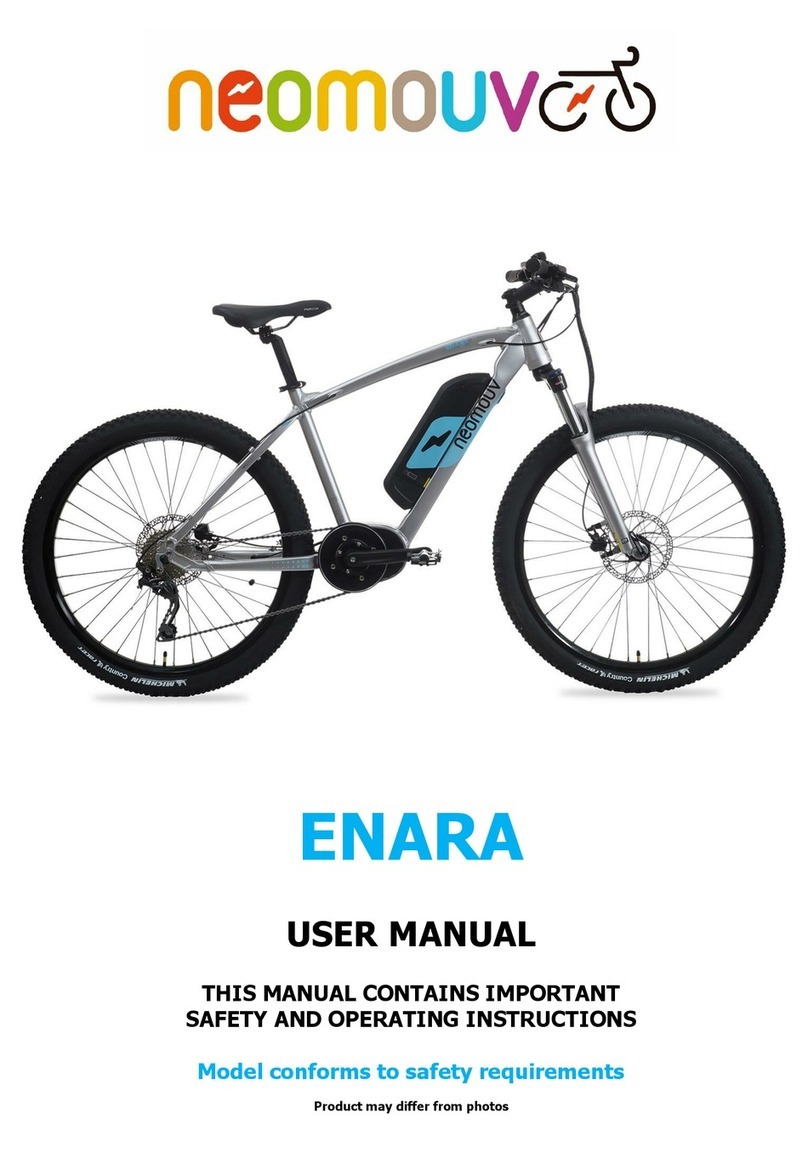
neomouv
neomouv ENARA User manual

neomouv
neomouv Montana Brose User manual

neomouv
neomouv FURTIVOO User manual
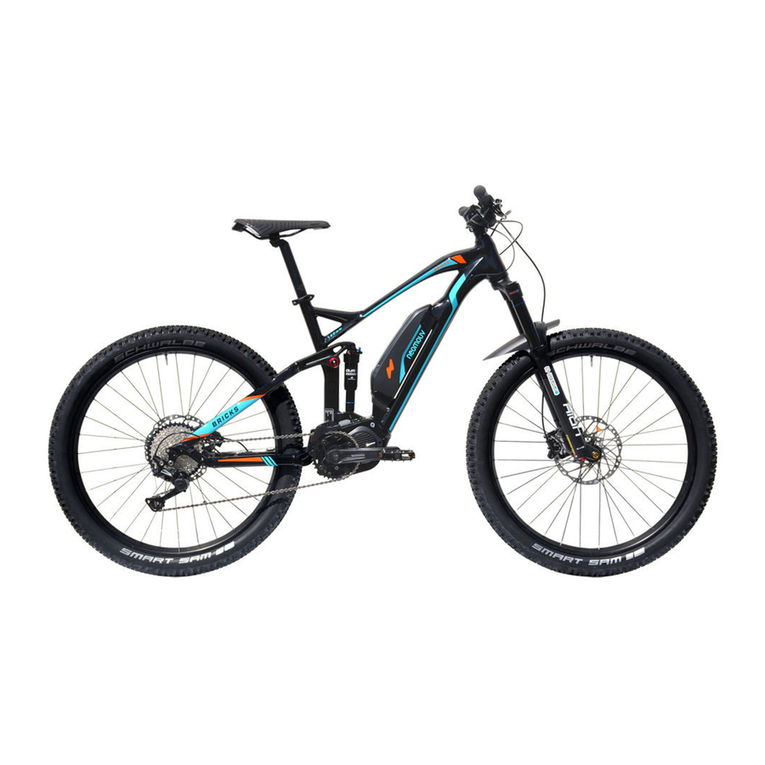
neomouv
neomouv Bricks User manual

neomouv
neomouv FACELIA N3 User manual
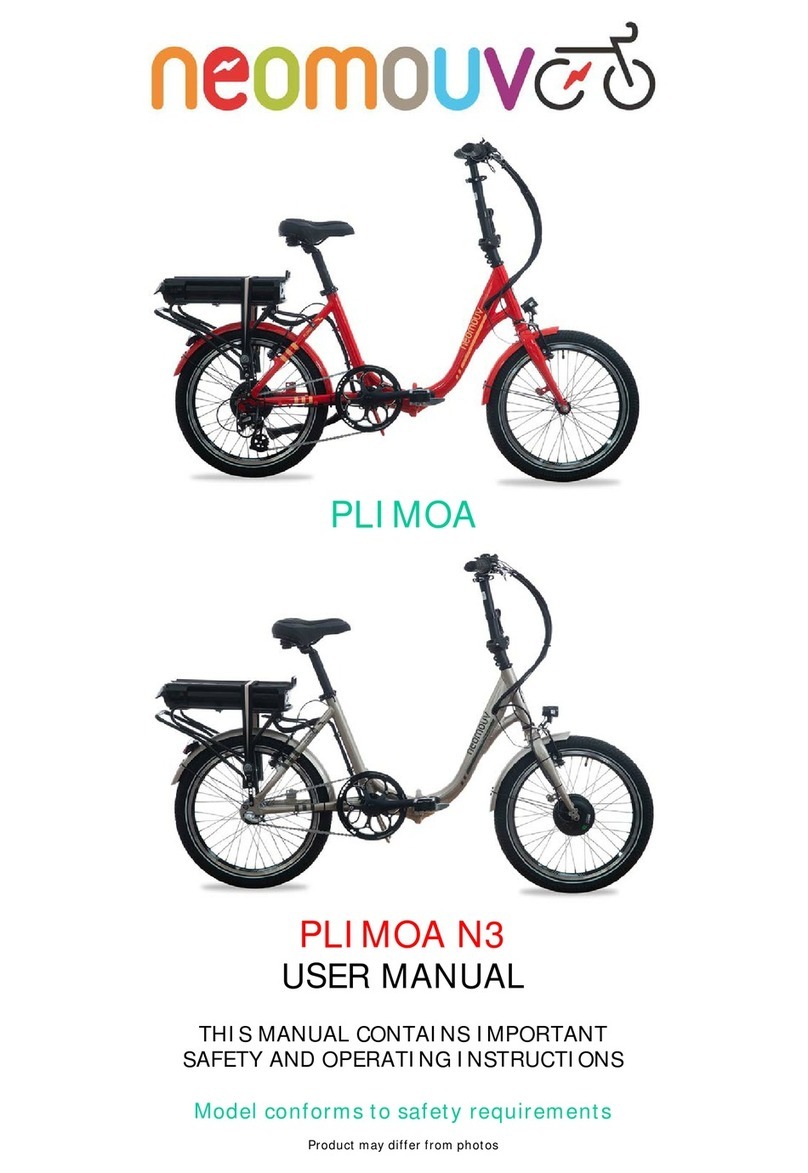
neomouv
neomouv PLIMOA User manual

neomouv
neomouv PLIMOA User manual

neomouv
neomouv CROONY User manual
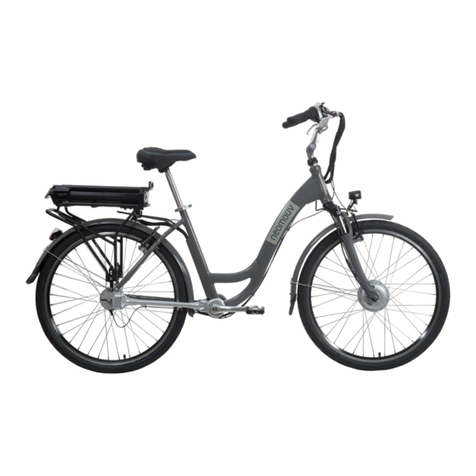
neomouv
neomouv DRIVE User manual
